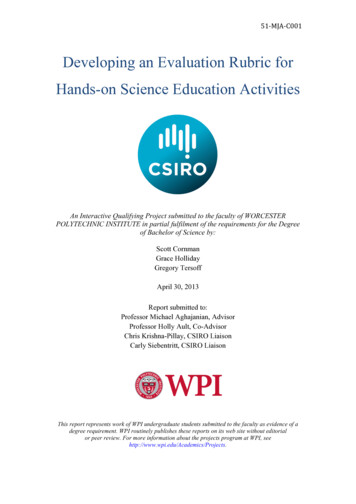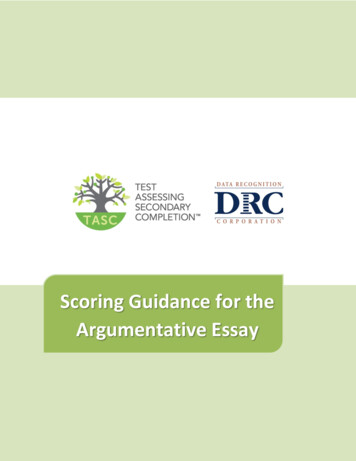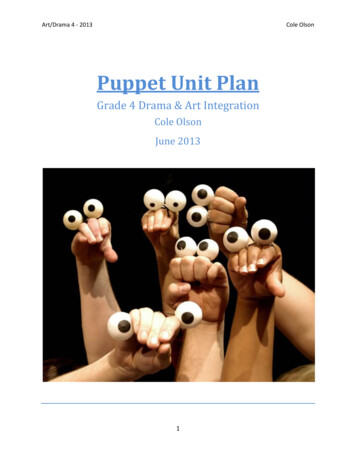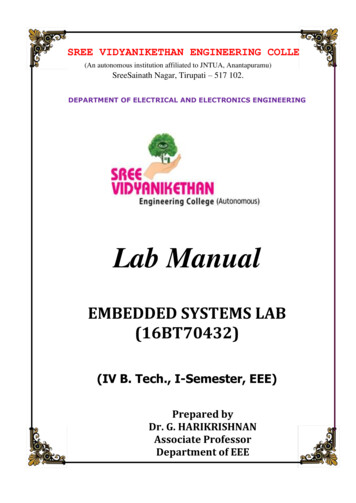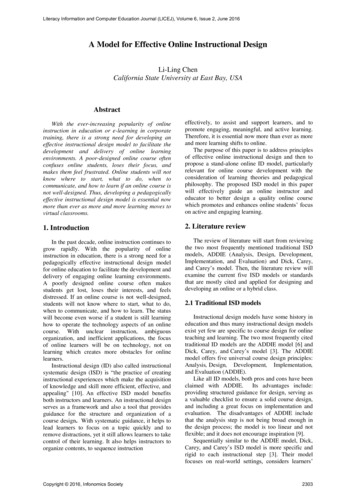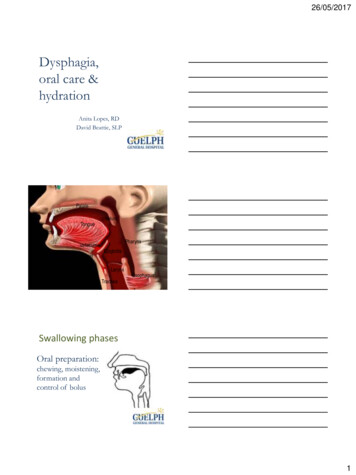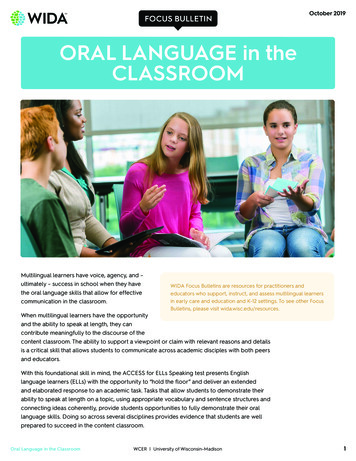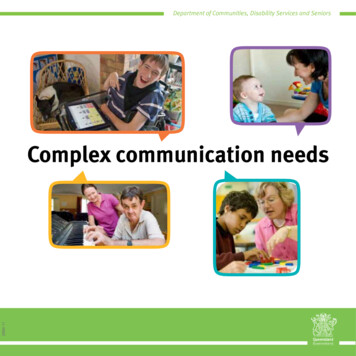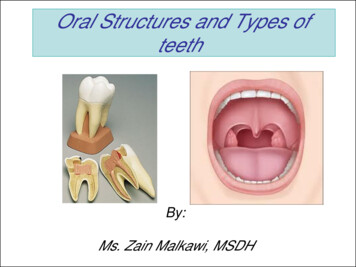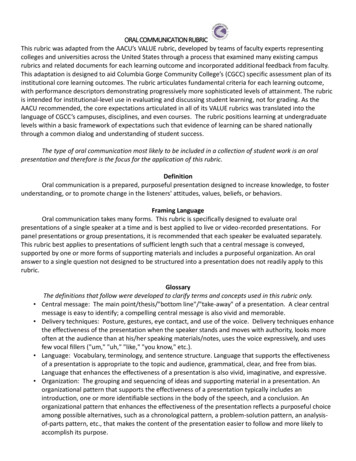
Transcription
ORAL COMMUNICATION RUBRICThis rubric was adapted from the AACU’s VALUE rubric, developed by teams of faculty experts representingcolleges and universities across the United States through a process that examined many existing campusrubrics and related documents for each learning outcome and incorporated additional feedback from faculty.This adaptation is designed to aid Columbia Gorge Community College’s (CGCC) specific assessment plan of itsinstitutional core learning outcomes. The rubric articulates fundamental criteria for each learning outcome,with performance descriptors demonstrating progressively more sophisticated levels of attainment. The rubricis intended for institutional-level use in evaluating and discussing student learning, not for grading. As theAACU recommended, the core expectations articulated in all of its VALUE rubrics was translated into thelanguage of CGCC’s campuses, disciplines, and even courses. The rubric positions learning at undergraduatelevels within a basic framework of expectations such that evidence of learning can be shared nationallythrough a common dialog and understanding of student success.The type of oral communication most likely to be included in a collection of student work is an oralpresentation and therefore is the focus for the application of this rubric.DefinitionOral communication is a prepared, purposeful presentation designed to increase knowledge, to fosterunderstanding, or to promote change in the listeners' attitudes, values, beliefs, or behaviors.Framing LanguageOral communication takes many forms. This rubric is specifically designed to evaluate oralpresentations of a single speaker at a time and is best applied to live or video-recorded presentations. Forpanel presentations or group presentations, it is recommended that each speaker be evaluated separately.This rubric best applies to presentations of sufficient length such that a central message is conveyed,supported by one or more forms of supporting materials and includes a purposeful organization. An oralanswer to a single question not designed to be structured into a presentation does not readily apply to thisrubric. GlossaryThe definitions that follow were developed to clarify terms and concepts used in this rubric only.Central message: The main point/thesis/"bottom line"/"take-away" of a presentation. A clear centralmessage is easy to identify; a compelling central message is also vivid and memorable.Delivery techniques: Posture, gestures, eye contact, and use of the voice. Delivery techniques enhancethe effectiveness of the presentation when the speaker stands and moves with authority, looks moreoften at the audience than at his/her speaking materials/notes, uses the voice expressively, and usesfew vocal fillers ("um," "uh," "like," "you know," etc.).Language: Vocabulary, terminology, and sentence structure. Language that supports the effectivenessof a presentation is appropriate to the topic and audience, grammatical, clear, and free from bias.Language that enhances the effectiveness of a presentation is also vivid, imaginative, and expressive.Organization: The grouping and sequencing of ideas and supporting material in a presentation. Anorganizational pattern that supports the effectiveness of a presentation typically includes anintroduction, one or more identifiable sections in the body of the speech, and a conclusion. Anorganizational pattern that enhances the effectiveness of the presentation reflects a purposeful choiceamong possible alternatives, such as a chronological pattern, a problem-solution pattern, an analysisof-parts pattern, etc., that makes the content of the presentation easier to follow and more likely toaccomplish its purpose.
Supporting material: Explanations, examples, illustrations, statistics, analogies, quotations fromrelevant authorities, and other kinds of information or analysis that supports the principal ideas of thepresentation. Supporting material is generally credible when it is relevant and derived from reliableand appropriate sources. Supporting material is highly credible when it is also vivid and varied acrossthe types listed above (e.g., a mix of examples, statistics, and references to authorities). Supportingmaterial may also serve the purpose of establishing the speakers credibility. For example, in presentinga creative work such as a dramatic reading of Shakespeare, supporting evidence may not advance theideas of Shakespeare, but rather serve to establish the speaker as a credible Shakespearean actor.
(oral/visual)Purpose ,memorable, andstronglysupported. Purposeandevidence are alignedwell.Organizationaldevelopment isclearly andconsistentlyobservable; skillfullymakescontent andexpression of ideasin the presentationcohesive.Language choicesareimaginative,memorable, andcompelling; choicesenhancepresentationeffectiveness.Language isappropriate toaudience and aidsthe clearexpression of ideas.Delivery techniquesmake thepresentationcompelling; speakerAccomplished3Developing2Beginning1Not Demonstrated0Purpose is clearandconsistent;purpose andevidence areappropriatelyaligned.Purpose isunderstandablebutis neitherreinforced normemorable;purpose andevidence aregenerally aligned.Purpose can bededuced, but isnot explicitlystated in thepresentation.Alignment ofpurpose andevidence is notalways clear.Purpose is absent;thepresentation doesnotseem to know whatit isabout. Unifyingprinciples do notexist.Organizationaldevelopmentand expression ofideas areclearly andconsistentlyobservable withinthepresentation;content isexpressedreasonably well asa result.Language choicesarethoughtful andgenerallysupport theeffectiveness ofthe presentation.Language isappropriate toaudience and isuseful to theexpression ofideas.Delivery techniquesmake thepresentationinteresting, andOrganizationaldevelopmentand expression ofideas areobservable withinthepresentationOrganizationaldevelopment andexpression of opment and/orexpression of ideasarenot observablewithin thepresentation; lackofcoherence andunityexist.Language choicesaremundane andcommonplaceand partiallysupport theeffectiveness of thepresentation andtheexpression of ideas.Language choicesaresometimes unclearandminimally supporttheeffectiveness of thepresentation.Languageappropriateness isinconsistent.Expression of ideasis hindered.Delivery techniquessometimesdetract fromaudienceLanguage choicesareunclear and fail tosupport theeffectivenessof the presentation.Language is notappropriate toaudience;ideas are notexpressedclearly.Delivery techniquesmake thepresentationunderstandable;Delivery techniquesareeither distractingfromNot Applicable
Evidence-basedsupportappears polishedand confident;speaker energy andemphasesfoster interpretationof ideasexpressed.Dependency uponnotes, if applicable,is not evidentor intrusive. Nonverbal cues aidsignificantly.speaker appearscomfortable;speaker tendstowardconversationaltone, anddependency uponnotes isminimallynoticeable.Nonverbalcues areappropriateand useful.speaker appearstentative;speaker tends to bea bitcasual, asevidenced in wordchoices; non-verbalcues donot particularlyelevateaudience’s level ofunderstanding orinterpretation.Supporting materialsmakeappropriatereference toinformation oranalysis andsignificantlyenhancedevelopment;materials ngmaterials makeappropriatereference toinformation oranalysis andgenerally tyis clear butevidence-basedsupport couldbe stronger.Supportingmaterials makeappropriatereference toinformation oranalysis but onlypartially fostersdevelopmentand presentation ofideas.Presenter'scredibility/authoritycould benefit frommore carefulexploration ofevidence.Adapted from AACU LEAP and SFA Oral Communication peakerseemsunenthusiastic,monotonic, orhesitanciessuggestunpreparedness.Verbal cues includeunnecessarygestures andpurposeless bodylanguage.Insufficientsupporting materialsprovide minimalinformation oranalysis;presenter'scredibility/authorityon the topicis not particularlyclear.understandability ofthepresentation or failto beeffective; thespeaker isclearlyuncomfortable orunprepared.Supportingmaterials arevirtually nonexistent, orthe supportingmaterialsare not credible.
WRITTEN COMMUNICATION RUBRICThis rubric was developed by an interdisciplinary team representing Columbia Gorge Community College through a process thatexamined and modified the AACU Written Communication Value Rubric to meet the needs of CGCC’s Institutional Core LearningOutcomes assessment. The rubric articulates fundamental criteria for each learning outcome, with performance descriptorsdemonstrating progressively more sophisticated levels of attainment. The rubric is intended for institutional-level use in evaluatingand discussing student learning, not for grading. The CGCC team agrees with the utility of the AACU Value rubric, which “is toposition learning at undergraduate levels within a basic framework of expectations such that evidence of learning can be sharednationally through a common dialog and understanding of student success”.DefinitionWritten communication is the development and expression of ideas in writing. Written communication involves learning towork in many genres and styles. It can involve working with many different writing technologies, and mixing texts, data, and images.Written communication abilities develop through iterative experiences across the curriculum.Framing LanguageThis rubric focuses assessment on how specific written work samples or collections of work respond to specific contexts.The central question guiding the rubric is "How well does writing respond to the needs of audience(s) for the work?" In focusing onthis question the rubric does not attend to other aspects of writing that are equally important: issues of writing process, writingstrategies, writers' fluency with different modes of textual production or publication, or writer's growing engagement with writingand disciplinarity through the process of writing.The first section of this rubric addresses the context and purpose for writing. A work sample or collections of work canconvey the context and purpose for the writing tasks it showcases by including the writing assignments associated with worksamples. But writers may also convey the context and purpose for their writing within the texts. It is important for faculty andinstitutions to include directions for students about how they should represent their writing contexts and purposes.GlossaryThe definitions that follow were developed to clarify terms and concepts used in this rubric only.Content Development: The ways in which the text explores and represents its topic in relation to its audience and purpose.Context of and purpose for writing: The context of writing is the situation surrounding a text: who is reading it? who is writing it?Under what circumstances will the text be shared or circulated? What social or political factors might affect how the text iscomposed or interpreted? The purpose for writing is the writer's intended effect on an audience. Writers might want to persuadeor inform; they might want to report or summarize information; they might want to work through complexity or confusion; theymight want to argue with other writers, or connect with other writers; they might want to convey urgency or amuse; they mightwrite for themselves or for an assignment or to remember.Disciplinary conventions: Formal and informal rules that constitute what is seen generally as appropriate within different academicfields, e.g. introductory strategies, use of passive voice or first person point of view, expectations for thesis or hypothesis,expectations for kinds of evidence and support that are appropriate to the task at hand, use of primary and secondary sources toprovide evidence and support arguments and to document critical perspectives on the topic. Writers will incorporate sourcesaccording to disciplinary and genre conventions, according to the writer's purpose for the text. Through increasingly sophisticateduse of sources, writers develop an ability to differentiate between their own ideas and the ideas of others, credit and build uponwork already accomplished in the field or issue they are addressing, and provide meaningful examples to readers.Evidence: Source material that is used to extend, in purposeful ways, writers' ideas in a text.Genre conventions: Formal and informal rules for particular kinds of texts and/or media that guide formatting, organization, andstylistic choices, e.g. lab reports, academic papers, poetry, webpages, or personal essays.Sources: Texts (written, oral, behavioral, visual, or other) that writers draw on as they work for a variety of purposes -- to extend,argue with, develop, define, or shape their ideas, for example.
WRITTEN COMMUNICATION RUBRICDefinition: Written communication is the development and expression of ideas in writing. Written communication involves learning to work in many genresand styles. It can involve working with many different writing technologies, and mixing texts, data, and images. Written communication abilities developthrough iterative experiences across the curriculum.Mastery4Demonstrates athoroughunderstanding ofcontext, audience,and purpose that iswholly responsiveto the assignedtask(s) and appliedconsistentlythrough allelements of tion ofcontext, audience,and purpose and aclear focus on theassigned task(s).Developing2Demonstratessome attention tocontext, audience,purpose, and to theassigned task(s).Beginning1Demonstratesminimal attentionto context,audience, purpose,and to the assignedtask(s).Not Demonstrated0Fails to meetminimum criteriain addressing theaudience, context,and purpose forwriting.ContentDevelopmentUses appropriate,relevant, andcompelling contentand ideas thatillustrate thewriter's commandand deepunderstanding ofthe subject,skillfully shapingthe whole work.Uses appropriate,relevant, andcompelling contentto accuratelyexplore ideaswithin the subjectand shape thewhole work.Uses appropriateand relevantcontent to developand accuratelyexplore ideasthrough most ofthe work.Uses appropriateand relevantcontent toaccurately developsimple ideas insome parts of thework.Fails to meetminimum criteriain addressingcontentdevelopment.Sources andEvidenceDemonstratesskillful use of highquality, credible,relevant sources todevelop ideas thatare appropriate forthe assignment.Demonstratesconsistent use ofcredible, relevantsources to supportideas that areappropriate for theassignment.Demonstrates anattempt to usecredible andrelevant sources tosupport ideas thatare appropriate forthe assignment.Demonstrates anattempt to usesources to supportideas in theassignment.Fails to meetminimum criteriain demonstratingthe use of sourcesto support ideas inthe assignment.Audience, Context,and PurposeNot Applicable
Organization AndPresentationDemonstratesconsistent, skillful,and thoroughlydetailed attentionto organization,presentation, andstylistic choices asappropriate to theassignment.Demonstratesconsistent andskillful organizationand presentation asappropriate to theassignment.Followsexpectations for aconsistent systemof basicorganization andpresentation asappropriate to theassignment.Attempts to use aconsistent systemfor basicorganization andpresentation asappropriate to theassignment.Fails to meetminimum criteriain organization andpresentation.Control of Syntaxand MechanicsUses gracefullanguage thatskillfullycommunicatesmeaning to readerswith clarity andfluency, and isnearly error-free.Usesstraightforwardlanguage thatconveys meaningto readers withclarity. Thelanguage in thework has fewerrors.Uses language thatgenerally conveysmeaning toreaders, althoughwriting may includesome errors.Uses language thatsometimesimpedes meaningbecause of errorsin usage.Fails to uselanguage thatdemonstratescontrol of syntaxand mechanics.Visual aidsVisual aidseffectively supportthe communicationof purposes andideas; aids areintegrated into thepresentationseamlessly, thusfostering a fullunderstanding ofthe message’scontent.Visual aidsgenerally supportthe communicationof the student’sideas and purposes;the aids effectivelyamplify or resonatethe presentation ofideas and foster agoodunderstanding ofthe message’scontent.Visual aids supportthe communicationof the student’sideas and purposesbut are onlypartially useful orinformative.Visual aids do notparticularlysupport thecommunication ofthe student’s ideasand purpose; theyare insufficient tobe of much use asthey do little toelevateunderstanding.Visual aids arevirtually nonexistent, serve nopurpose, or are notcredibleAdapted from AACU LEAP and SFA Written Communication Rubrics
CRITICAL THINKING RUBRICThis rubric was adapted by an interdisciplinary team representing Columbia Gorge Community College through a process that examined and modified the AACU CriticalThinking Value Rubric to meet the needs of CGCC’s Institutional Core Learning Outcomes assessment. The rubric articulates fundamental criteria for each learning outcome, withperformance descriptors demonstrating progressively more sophisticated levels of attainment. The rubric is intended for institutional-level use in evaluating and discussingstudent learning, not for grading. The CGCC team agrees with the utility of the AACU Value rubric, which “is to position learning at undergraduate levels within a basic frameworkof expectations such that evidence of learning can be shared nationally through a common dialog and understanding of student success”.DefinitionCritical thinking is a habit of mind characterized by the comprehensive exploration of issues, ideas, artifacts, and events before accepting or formulating an opinion orconclusion.Framing LanguageThis rubric is designed to be transdisciplinary, reflecting the recognition that success in all disciplines requires habits of inquiry and analysis that share common attributes.Further, research suggests that successful critical thinkers from all disciplines increasingly need to be able to apply those habits in various and changing situations encountered inall walks of life.This rubric is designed for use with many different types of assignments and the suggestions here are not an exhaustive list of possibilities. Critical thinking can bedemonstrated in assignments that require students to complete analyses of text, data, or issues. Assignments that cut across presentation mode might be especially useful insome fields. If insight into the process components of critical thinking (e.g., how information sources were evaluated regardless of whether they were included in the product) isimportant, assignments focused on student reflection might be especially illuminating. GlossaryThe definitions that follow were developed to clarify terms and concepts used in this rubric only.Ambiguity: Information that may be interpreted in more than one way.Assumptions: Ideas, conditions, or beliefs (often implicit or unstated) that are "taken for granted or accepted as true without proof." (quoted s)Context: The historical, ethical. political, cultural, environmental, or circumstantial settings or conditions that influence and complicate the consideration of any issues,ideas, artifacts, and events.Literal meaning: Interpretation of information exactly as stated. For example, "she was green with envy" would be interpreted to mean that her skin was green.Metaphor: Information that is (intended to be) interpreted in a non-literal way. For example, "she was green with envy" is intended to convey an intensity of emotion,not a skin color.
CRITICAL THINKING RUBRICDefinitionCritical thinking is a habit of mind characterized by the comprehensive exploration of issues, ideas, artifacts, and events before accepting or formulating an opinion or conclusion.Mastery4Explanation ofissuesEvidenceSelecting andusing informationto investigate apoint of view orconclusionInfluence ofcontext andassumptionsStudent's em to beconsidered critically isstated clearly anddescribedcomprehensively,delivering all relevantinformation necessaryfor full understanding.Information is takenfrom source(s) withenoughinterpretation/evaluationto develop acomprehensive analysisor synthesis.Viewpoints of expertsare questionedthoroughly.Thoroughly(systematically andmethodically) analyzesown and others'assumptions andcarefully evaluates therelevance of contextswhen presenting aposition.Specific position(perspective,thesis/hypothesis) isimaginative, taking intoaccount the complexitiesof an issue.Limits of positionAccomplished3Issue/problem to beconsidered critically isstated, described, andclarified so thatunderstanding is notseriously impeded byomissions.Developing2Beginning1Not Demonstrated0No explanation ofissues is evident.Not ApplicableIssue/problem to beconsidered critically isstated but descriptionleaves some termsundefined, ambiguitiesunexplored, boundariesundetermined, and/orbackgrounds unknown.Information is taken fromsource(s) with someinterpretation/evaluation,but not enough todevelop a coherentanalysis or synthesis.Viewpoints of experts aretaken as mostly fact, withlittle questioning.Issue/problem to beconsidered critically isstated withoutclarification ordescription.Information is taken fromsource(s) without anyinterpretation/evaluation.Viewpoints of experts aretaken as fact, withoutquestion.No information fromsources or viewpointsof experts are evident.Evidence (informationfrom sources) is notrequired for theassignment.Identifies own andothers' assumptions andseveral relevant contextswhen presenting aposition.Questions someassumptions. Identifiesseveral relevant contextswhen presenting aposition. May be moreaware of others'assumptions than one'sown (or vice versa).Shows an emergingawareness of presentassumptions (sometimeslabels assertions asassumptions). Begins toidentify some contextswhen presenting aposition.Shows no awareness ofassumptions. Does notidentify contexts whenpresenting a positionAwareness of influenceof context andassumptions is notrequired for theassignment.Specific position(perspective,thesis/hypothesis) takesinto account thecomplexities of an issue.Others' points of vieware acknowledged withinSpecific s differentsides of an issue.Specific position(perspective,thesis/hypothesis) isstated, but is simplisticand obvious.Specific position is notstated.Student’s position is notrequired to be stated forassignment.Information is takenfrom source(s) withenoughinterpretation/evaluationto develop a coherentanalysis or synthesis.Viewpoints of expertsare subject toquestioning.Explanation of issues isnot required for theassignment
(perspective,position (perspective,thesis/hypothesis) arethesis/hypothesis).acknowledged.Others' points of vieware synthesized withinposition (perspective,thesis/hypothesis).Conclusions andConclusions and relatedConclusion is logicallyrelated outcomes outcomes (consequences tied to a range of(implications andand implications) areinformation, includingconsequences)logical and reflectopposing viewpoints;student’s informedrelated outcomesevaluation and ability to(consequences andplace evidence andimplications) areperspectives discussed in identified clearly.priority order.Adapted from AACU LEAP Critical Thinking RubricConclusion is logicallytied to information(because information ischosen to fit the desiredconclusion); some relatedoutcomes (consequencesand implications) areidentified clearly.Conclusion isinconsistently tied tosome of the informationdiscussed; relatedoutcomes (consequencesand implications) areoversimplified.No conclusion is statedor impliedStudent is not requiredto provide a conclusionfor the assignment.
PROBLEM SOLVING RUBRICThis rubric was adapted by an interdisciplinary team representing Columbia Gorge Community College through a process that examined and modified the AACU Problem Solving ValueRubric to meet the needs of CGCC’s Institutional Core Learning Outcomes assessment. The rubric articulates fundamental criteria for each learning outcome, with performance descriptorsdemonstrating progressively more sophisticated levels of attainment. The rubric is intended for institutional-level use in evaluating and discussing student learning, not for grading. The CGCCteam agrees with the utility of the AACU Value rubric, which “is to position learning at undergraduate levels within a basic framework of expectations such that evidence of learning can beshared nationally through a common dialog and understanding of student success”.DefinitionProblem solving is the process of designing, evaluating and implementing a strategy to answer an open-ended question or achieve a desired goal.Framing LanguageProblem-solving covers a wide range of activities that may vary significantly across disciplines. Activities that encompass problem-solving by students may involve problems that rangefrom well-defined to ambiguous in a simulated or laboratory context, or in real-world settings. This rubric distills the common elements of most problem-solving contexts and is designed tofunction across all disciplines. It is broad-based enough to allow for individual differences among learners, yet is concise and descriptive in its scope to determine how well students havemaximized their respective abilities to practice thinking through problems in order to reach solutions.This rubric is designed to measure the quality of a process, rather than the quality of an end-product. As a result, work samples or collections of work will need to include someevidence of the individual’s thinking about a problem-solving task (e.g., reflections on the process from problem to proposed solution; steps in a problem-based learning assignment; record ofthink-aloud protocol while solving a problem). The final product of an assignment that required problem resolution is insufficient without insight into the student’s problem-solving process.Because the focus is on institutional level assessment, scoring team projects, such as those developed in capstone courses, may be appropriate as well. GlossaryThe definitions that follow were developed to clarify terms and concepts used in this rubric only.Contextual Factors: Constraints (such as limits on cost), resources, attitudes (such as biases) and desired additional knowledge which affect how the problem can be best solved in thereal world or simulated setting.Critique: Involves analysis and synthesis of a full range of perspectives.Feasible: Workable, in consideration of time-frame, functionality, available resources, necessary buy-in, and limits of the assignment or task.“Off the shelf”solution: A simplistic option that is familiar from everyday experience but not tailored to the problem at hand (e.g. holding a bake sale to "save" an underfunded publiclibrary).Solution: An appropriate response to a challenge or a problem.Strategy: A plan of action or an approach designed to arrive at a solution. ( If the problem is a river that needs to be crossed, there could be a construction-oriented, cooperative (build abridge with your community) approach and a personally oriented, physical (swim across alone) approach. An approach that partially applies would be a personal, physical approach forsomeone who doesn't know how to swim.Support: Specific rationale, evidence, etc. for solution or selection of solution.
PROBLEM SOLVING RUBRICDefinitionProblem solving is the process of designing, evaluating, and implementing a strategy to answer an open-ended question or achieve a desired goal.Define ProblemMastery4Demonstrates the abilityto construct a clear andinsightful problemstatement with evidenceof all relevant contextualfactors.Identify StrategiesIdentifies multipleapproaches for solvingthe problem that applywithin a specific context.ProposeSolutions/HypothesesProposes one or moresolutions/hypothesesthat indicates a deepcomprehension of theproblem.Solution/hypotheses aresensitive to contextualfactors as well as all ofthe following: ethical,logical, and culturaldimensions of theproblem.Accomplished3Demonstrates the abilityto construct a problemstatement with evidenceof most relevantcontextual factors, andproblem statement isadequately detailed.Identifies multipleapproaches for solvingthe problem, only someof which apply within aspecific context.Proposes one or moresolutions/hypothesesthat indicatescomprehension of theproblem.Solutions/hypotheses aresensitive to contextualfactors as well as the oneof the following: ethical,logical, or culturaldimensions of theproblem.Developing2Begins to demonstratethe ability to construct aproblem statement withevidence of mostrelevant contextualfactors, but problemstatement is superficial.Identifies only a singleapproach for solving theproblem that does applywithin a specific context.Proposes onesolution/hypothesis thatis “off the shelf” ratherthan individuallydesigned to address thespecific contextualfactors of the problem.Beginning1Demonstrates a limitedability in identifying aproblem statement orrelated contextualfactors.Not Demonstrated0No problem statement orrelated contextualfactors are identified.Not ApplicableIdentification of aproblem is not requiredfor the assignmentIdentifies one or moreapproaches for solvingthe problem that do notapply within a specificcontext.Proposes asolution/hypothesis thatis difficult to evaluatebecause it is vague oronly indirectly addressesthe problem statement.Does not identify anyapproaches for solvingthe problem.Identifying approaches isnot required for theassignment.Does not propose asolution/hypothesis.Pro
The rubric articulates fundamental criteria for each learning outcome, with performance descriptors demonstrating progressively more sophisticated levels of attainment. The rubric is intended for institutional-level use in evaluating and discussing student learning, not for grading. The CGCC team agrees with the utility of the AACU Value rubric .
